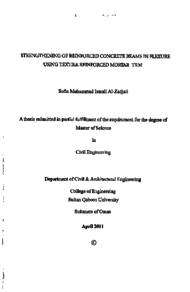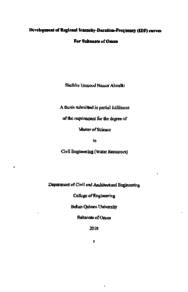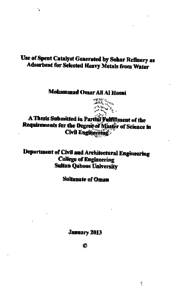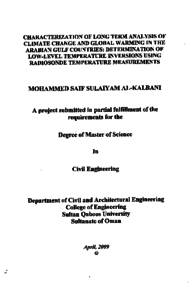Document
Experimental and numerical study of model strip footing resting on geogrid-reinforced dune sand.
Publisher
Sultan Qaboos University
Gregorian
2019
Language
English
Subject
English abstract
This research presents an experimental and numerical investigation on the behavior of strip footing resting on geogrid-reinforced dune sand. The tests were performed on a rigid steel tank having a glass sides and footings made of steel. The depth of the footing, the depth of the geogrids, and number of geogrid layers were the main parameters in this study. Footings were placed at the surface of sand bed or at 0.25B (where B is width of the footing) from the surface of the sand bed. Geogrids were placed at different depths below the footing from 0.25B to B. The number of geogrids layers was varied from 0 to 4 layers. The sand was placed in the tank and compacted. In numerical part, ANSYS program was used to simulate the model footing on geogrids reinforced sand using 3-dimensional finite elements. The load was applied in increments at the location of the footing and for each increment the settlement at the center of the model footing was computed. The main objectives of this study are to study the settlement of model footing on dune sand reinforced with geogrid, to simulate model footing on dune sand reinforced with geogrid using 3D finite element, to assess the consistency between the results of the model test and simulation and to study the effect of different factors on the performance of footing on dune sand such as, footing depth, geogrid depth and number of geogrid layers.
Good agreement was obtained between the numerical method and the experimental results in measuring the settlement, especially in the elastic range. The results indicated that the use of more geogrids layers improved the ultimate bearing capacity of strip footings and reduced the settlement. For case of using one layer of geogrids the highest improvement is when the depth of the reinforcement below the footing was 0.75B. For the use of one layer of geogrid and footing at 0.25B, the highest improvement is when the depth of the reinforcement below the footing was 0.5B, while when using two layers of geogrids, the highest improvement is when the depth of reinforcement below the footing is at 0.25B and 0.75B. For three layer of geogrids, failure was not reached for both surface footing and the footing at depth of 0.25B . However, the allowable bearing capacity is higher for surface footing than footing at 0.25B. The best improvement in ultimate bearing capacity (qu), allowable bearing capacity (qa), and bearing capacity ratio (BCR) was for the case of using four layers of geogrids.
Member of
Resource URL
Arabic abstract
يقدم هذا البحث دراسة عملية وعددية حول سلوك الأساسات على رمل ناعم من الكثبان الرملية و مقوى بإستخدام geogrid (مقوى بلاستيكي) . تم إجراء الاختبارات في خزان فولاذي صلب ذو جانب زجاجي ذي أبعاد داخلية تبلغ 1000 ملم و 640 ملم و 230 ملم الأساس مصنوع من الفولاذ وله أبعاد 90x80x230. شمل البحث مجموعة من العوامل التي تؤثر على سلوك الأساسات وهي عدد وعمق مقوى بلاستيكي) وعمق الأساس . حيث وضع الأساس على عمقين وهما على سطح الرمل و علی0. 25 B. (حيث B هي عرض الأساس تحت سطح الرمل) ووضع طبقات ال geogrid على أعماق مختلفة بدءا من 0. 25 B الی B1 وتراوح عدد طبقات ال eogridsي من 1 الی 4 طبقات. تم وضع الرمل باستخدام طريقة الدمك. بالنسبة للتحليل العددي ، تم استخدام برنامج (ANSYS) لمحاكاة أسلوب نموذج الأساس في عنصر ثلاثي الأبعاد. أشارت النتائج إلى أن استخدام كمية عالية من طبقات ال geogrids قد زاد من قدرة تحمل الأساس وقلل من مستوى الهبوط بالنسبة لاستخدام طبقة واحدة من geogrid ، يكون التحسن الأمثل عندما تكون طبقة ال geogrid على عمق 0. 75B أسفل الأساس هو يكون على عمق التغريز أسفل الأساس B0 . 75 . وبالنسبة لأستخدام طبقتين من geogrid يكون التحسن الأمثل هو عندما يكون عمق طبقات geogrid أسفل الأساس مابين B0. 25 و B0. 75 . عند استخدام طريقة الدمك، ستخضع الأساس لتثبيت لدرجة أكبر وتتحمل المزيد من الدمك على عكس طريقة الاستمطار. تم الحصول على اتفاق جيد بين التحليل العددي والطريقة العملية لقياس مستوى التسويه للرمل.
Category
Theses and Dissertations







